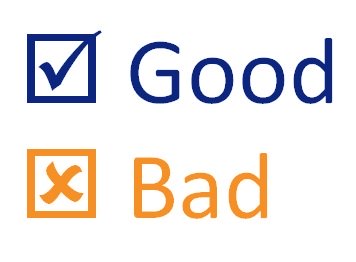|
Dimension
|
Poor Trading System
|
Good Trading System
|
Actions
|
|
Trading Strategy
|
- No clear philosophy
- Trading rules derived from trial and
error or data-mining
- Trader not able to explain the
philosophy and trading strategy behind the system in a 30 second 'elevator
pitch'.
-
Rules inconsistent
with chosen trading strategy
|
- Good trading systems are backed by a
sound trading strategy / philosophy (Eg. Markets trend and entering a position
in an established trend and holding till the trend changes has a positive
expectancy)
- Trading rules are hypothesis based and
capture the essence of the trading strategy
- Good trading system logic simple and
easy to explain
- Trading rules 100% consistent with
trading strategy
|
- Choose one of the major trading strategies that appeals to you and
learn more about it.
- Do not undertake any trading system
development work until you have chosen a trading strategy
- Develop your system to be 100%
consistent you’re your trading strategy
- Follow the correct trading system
development process
|
Complexity
|
- Complex rules based on mathematical manipulations
of price and volume data
- Use highly specific market conditions as rules
- Multiple rules or conditions required to enter
or exit
|
-
Good trading systems have simple rules
that are based on price and volume (and potentially other data) rather than
complex derivations the raw data
- Few conditions required to satisfy
entry or exit criteria
|
- Challenge yourself to express your
trading strategy in the simplest way possible
- Do not layer many conditions for your
entries or exits to improve historical simulations – this results in curve
fitting
|
Adaptive
|
-
Refer to absolute price levels or
changes for entry or exit rules
- Use percentage moves for profit targets
or initial stop losses
- Both of the above are poor practice
because market character changes over time, so absolute levels or changes
become irrelevant over time
|
- Good trading system rules adjust for market volatility using calculations such as ATR or Standard Deviation
- This takes into account the changing character of markets
- This also makes systems transferrable across multiple instruments or markets
|
- Avoid reference to absolute price or
percentage changes as these lose relevance over time.
- Express any movement in volatility
adjusted terms using ATR or standard deviation. This helps system portability
between instruments
-
If you want to refer to price, use a
formula that adjusts to the recent price movement such as the Highest Close in
the past 20 days, yesterday's close. todays open etc
|
Degrees of freedom / number of rules
|
-
Large number of rules specified
- Criteria stacked on top of each other
in a string of 'AND' statements to highly specify a conditions for action
(especially entry signals)
- More
than ~10 rules required to specify the entire system
|
- A good trading system has few rules
specified. Ideally 6 or less across the entire system
- Simple criteria for entry trigger
|
-
Set a budget of how many rules you will
have in total and stick to it
- Aim for 6 rules to specify the whole
system and reduce further if possible
- This can be difficult, but it will
prevent rampant curve fitting and give your system more chance of working in
the future
|
Optimization
|
- Many parameters are optimized to give the best hypothetical back test
results
|
- Correct optimization of a small number of parameters to ensure system
performance is stable and robust
|
- Understand and practice correct
optimization to avoid curve fitting
|
Exit Specification
|
- Exit rules poorly designed and unable to deal with all possible
situations
|
- Exit rules fully specified to ensure that there is always a clear exit
point no matter what market conditions emerge
|
- Perform a mental scenario review of all possible market movements once
you get into a trade and ensure your exit rules account for all scenarios
|
Transferrable
|
- Designed to be highly specific to a
single market
- Generates poor trading results in other
related markets and losses in unrelated markets
|
- A good trading system which is robust
and non-curve fitted system should work well across a wide variety of markets
- For example, a simple trend
following system can work well on stocks, futures and forex with no
modifications at all
|
- Avoid developing market specific
systems if you are a new trader
- Plan your optimization routine in
advance and ensure you optimize correctly
- Ensure your historical testing and
optimization covers markets from all different conditions - volatile /
quiet and up / down / sideways
- Ensure testing generates enough
historical trades to be sure of system performance (the more the better, but
several hundred as a minimum)
|
R-Multiples
(Return per dollar risked)
|
- High variability (standard deviation)
of trade outcomes relative to the average profit per trade
- Large losing R-Multiple trades appear
in the historical simulation which could wipe you out
- Trading rules make it likely that a
large R-Multiple losing trades may emerge in the future (e.g. Using extremely
tight stops on volatile stocks)
|
- Low variability (standard deviation) of
trade outcomes relative to the average profit per trade
- No Large (-10R or greater) losing
trades found during simulation
- Large losing trades are not likely
based on the trading system logic
|
- Generate an R-Multiple trade
distribution for your system’s historical performance and ensure that there are
no large losing R-Multiples
- Perform mental scenario testing on your
trading system logic to determine if extremely large loses could occur
- Adjust logic if required to reduce this
risk (e.g. widen stops)
|
Average profit per trade
|
- Low relative to a realistic assessment
or slippage and commissions
-
This
leaves no room for error if slippage increases or if market character changes
|
- Average profit per trade substantially
higher than the cost of slippage and commissions
-
Allows
for changes in slippage and market character without the system self
destructing
|
- Determine the average profit per trade
excluding slippage and commissions based on historical backtests
- Research the likely slippage and
commissions for your chosen markets
- Calculate average profit per trade
including these costs
- Ensure the system remains profitable
and equity curve remains attractive including these assumptions
|
Opportunity
|
- The system generates so few trades
that real time performance will be extremely lumpy
OR -
The
system generates so many trades that it is impossible to take them all and
there is no mechanism other than ‘discretion’ to select between trades
|
- A good trading system generates a
sufficiently large number of trades that there is ample profit opportunity over
the year (greater than 100 trades is preferable)
- If the system generates more trades
than the portfolio can handle there are objective rules for how to prioritize
trades
|
- Measure how many trades your system
generates each year and ensure it is large enough to make you money but not so
large that you get swamped
- Measure how many trades each rule you
add to your system impacts. If a rule only impacts a small number of trades
(say <30) then it is probably not statistically valid and should be removed
|
 The differences between a good and bad trading system can be hard to see at first glance.
The differences between a good and bad trading system can be hard to see at first glance.

